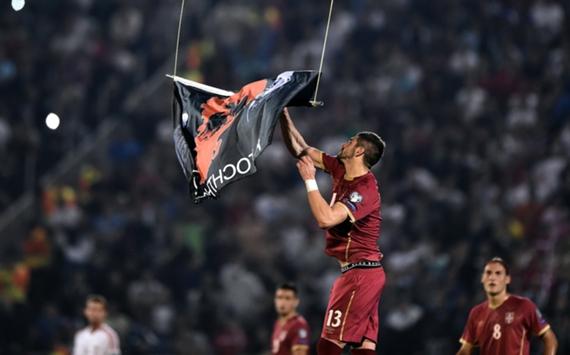By Kyle Herda
Impunity Watch Reporter, Europe
BELGRADE, Serbia – A Euro 2016 qualifying match between Albania and Serbia ended abruptly due to a drone carrying a controversial flag that interrupted the game and sparked a riot.

Around 41 minutes into the match, a drone flew over the stadium while carrying a flag depicting the “Greater Albania”, which was shown to include Kosovo. When Serbian player Stefan Mitrovic took down the flag, a brawl quickly erupted. Martin Atkinson, an English referee on the field, tried to take players off the field, but it was too late. A brawl erupted between the two teams, with referees and fans soon finding themselves in the middle of it as well.
Two political figures were also on the flag. The first, Isa Boljetini, was an Albanian nationalist who led uprisings against the Serbs and Ottomans in 1912 and 1913. The second figure was Ismail Qemali, the founder of the modern Albanian state, which gained independence back in 1912.
While some countries recognize Kosovo’s independence, such as the United States, the United Kingdom, Germany, and France, other countries do not. Even after Kosovo’s 2008 declaration of independence, Serbia is among those countries that do not recognize Kosovo as an independent state.
Olsi Rama, brother of Albanian Prime Minister Edi Rama, was detained by police on suspicion of being the one responsible for the drone. Serbian Prime Minister Aleksandar Vucic, however, insisted Rama be released and allowed back home.
This was the first match Albania has played in Belgrade since 1967, and given the ethnic war in 1999 and Kosovo’s independence in 2008 that have happened since, tensions were already high going into the match. Away fans were not present, and so once the fighting began, the Albanian team was outnumbered. Serbian captain, Branislav Ivanovic, claims that his team “shielded the Albanian players every step of the way to the tunnel.” Albanian captain, Lorik Cana, reports that his players were “being attacked and hit even inside the tunnel, and even by the stewards.” Furthermore, Albania’s coach, Giovanni de Biazzi, reports that four of his players were injured from the incident.
For more information, please see:
CNN – Serbia and Albania game abandoned after drone invasion sparks brawl – 15 October 2014
Reuters – Serbia-Albania match abandoned following drone stunt, brawl – 15 October 2014
The Guardian – Albania and Serbia face heavy Uefa sanctions after abandoned game – 15 October 2014
The Telegraph – Serbia accuses Albania of ‘terrorist action’ with drone carrying flag as both countries charge by Uefa for violence – 15 October 2014
The Washington Post – UPDATED: Drone toting pro-Albanian flag causes riots that end Albania vs. Serbia Euro 2016 qualifier early – 14 October 2014


